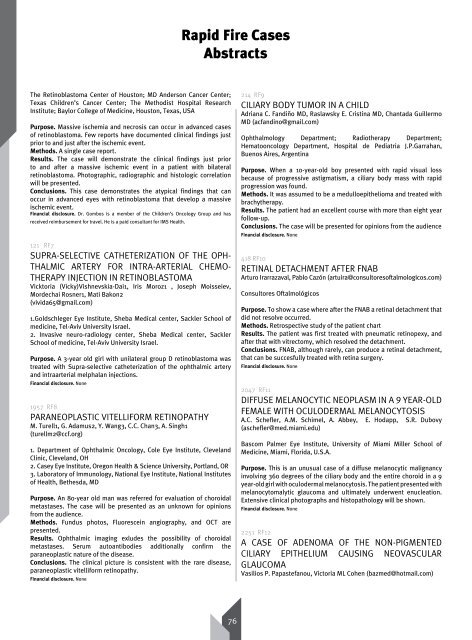Program Book
Program Book
Program Book
Create successful ePaper yourself
Turn your PDF publications into a flip-book with our unique Google optimized e-Paper software.
The Retinoblastoma Center of Houston; MD Anderson Cancer Center;<br />
Texas Children’s Cancer Center; The Methodist Hospital Research<br />
Institute; Baylor College of Medicine, Houston, Texas, USA<br />
Purpose. Massive ischemia and necrosis can occur in advanced cases<br />
of retinoblastoma. Few reports have documented clinical findings just<br />
prior to and just after the ischemic event.<br />
Methods. A single case report.<br />
Results. The case will demonstrate the clinical findings just prior<br />
to and after a massive ischemic event in a patient with bilateral<br />
retinoblastoma. Photographic, radiographic and histologic correlation<br />
will be presented.<br />
Conclusions. This case demonstrates the atypical findings that can<br />
occur in advanced eyes with retinoblastoma that develop a massive<br />
ischemic event.<br />
Financial disclosure. Dr. Gombos is a member of the Children’s Oncology Group and has<br />
received reimbursement for travel. He is a paid consultant for IMS Health.<br />
121 RF7<br />
SUPRA-SELECTIVE CATHETERIZATION OF THE OPH-<br />
THALMIC ARTERY FOR INTRA-ARTERIAL CHEMO-<br />
THERAPY INJECTION IN RETINOBLASTOMA<br />
Vicktoria (Vicky)Vishnevskia-Dai1, Iris Moroz1 , Joseph Moisseiev,<br />
Mordechai Rosner1, Mati Bakon2<br />
(vivida65@gmail.com)<br />
1.Goldschleger Eye Institute, Sheba Medical center, Sackler School of<br />
medicine, Tel-Aviv University Israel.<br />
2. Invasive neuro-radiology center, Sheba Medical center, Sackler<br />
School of medicine, Tel-Aviv University Israel.<br />
Purpose. A 3-year old girl with unilateral group D retinoblastoma was<br />
treated with Supra-selective catheterization of the ophthalmic artery<br />
and intraarterial melphalan injections.<br />
Financial disclosure. None<br />
1957 RF8<br />
PARANEOPLASTIC VITELLIFORM RETINOPATHY<br />
M. Turell1, G. Adamus2, Y. Wang3, C.C. Chan3, A. Singh1<br />
(turellm2@ccf.org)<br />
1. Department of Ophthalmic Oncology, Cole Eye Institute, Cleveland<br />
Clinic, Cleveland, OH<br />
2. Casey Eye Institute, Oregon Health & Science University, Portland, OR<br />
3. Laboratory of Immunology, National Eye Institute, National Institutes<br />
of Health, Bethesda, MD<br />
Purpose. An 80-year old man was referred for evaluation of choroidal<br />
metastases. The case will be presented as an unknown for opinions<br />
from the audience.<br />
Methods. Fundus photos, Fluorescein angiography, and OCT are<br />
presented.<br />
Results. Ophthalmic imaging exludes the possibility of choroidal<br />
metastases. Serum autoantibodies additionally confirm the<br />
paraneoplastic nature of the disease.<br />
Conclusions. The clinical picture is consistent with the rare disease,<br />
paraneoplastic vitelliform retinopathy.<br />
Financial disclosure. None<br />
Rapid Fire Cases<br />
Abstracts<br />
76<br />
214 RF9<br />
CILIARY BODY TUMOR IN A CHILD<br />
Adriana C. Fandiño MD, Raslawsky E. Cristina MD, Chantada Guillermo<br />
MD (acfandino@gmail.com)<br />
Ophthalmology Department; Radiotherapy Department;<br />
Hematooncology Department, Hospital de Pediatria J.P.Garrahan,<br />
Buenos Aires, Argentina<br />
Purpose. When a 10-year-old boy presented with rapid visual loss<br />
because of progressive astigmatism, a ciliary body mass with rapid<br />
progression was found.<br />
Methods. It was assumed to be a medulloepithelioma and treated with<br />
brachytherapy.<br />
Results. The patient had an excellent course with more than eight year<br />
follow-up.<br />
Conclusions. The case will be presented for opinions from the audience<br />
Financial disclosure. None<br />
418 RF10<br />
RETINAL DETACHMENT AFTER FNAB<br />
Arturo Irarrazaval, Pablo Cazón (artuira@consultoresoftalmologicos.com)<br />
Consultores Oftalmológicos<br />
Purpose. To show a case where after the FNAB a retinal detachment that<br />
did not resolve occurred.<br />
Methods. Retrospective study of the patient chart<br />
Results. The patient was first treated with pneumatic retinopexy, and<br />
after that with vitrectomy, which resolved the detachment.<br />
Conclusions. FNAB, although rarely, can produce a retinal detachment,<br />
that can be succesfully treated with retina surgery.<br />
Financial disclosure. None<br />
2047 RF11<br />
DIFFUSE MELANOCYTIC NEOPLASM IN A 9 YEAR-OLD<br />
FEMALE WITH OCULODERMAL MELANOCYTOSIS<br />
A.C. Schefler, A.M. Schimel, A. Abbey, E. Hodapp, S.R. Dubovy<br />
(aschefler@med.miami.edu)<br />
Bascom Palmer Eye Institute, University of Miami Miller School of<br />
Medicine, Miami, Florida, U.S.A.<br />
Purpose. This is an unusual case of a diffuse melanocytic malignancy<br />
involving 360 degrees of the ciliary body and the entire choroid in a 9<br />
year-old girl with oculodermal melanocytosis. The patient presented with<br />
melanocytomalytic glaucoma and ultimately underwent enucleation.<br />
Extensive clinical photographs and histopathology will be shown.<br />
Financial disclosure. None<br />
2251 RF12<br />
A CASE OF ADENOMA OF THE NON-PIGMENTED<br />
CILIARY EPITHELIUM CAUSING NEOVASCULAR<br />
GLAUCOMA<br />
Vasilios P. Papastefanou, Victoria ML Cohen (bazmed@hotmail.com)


